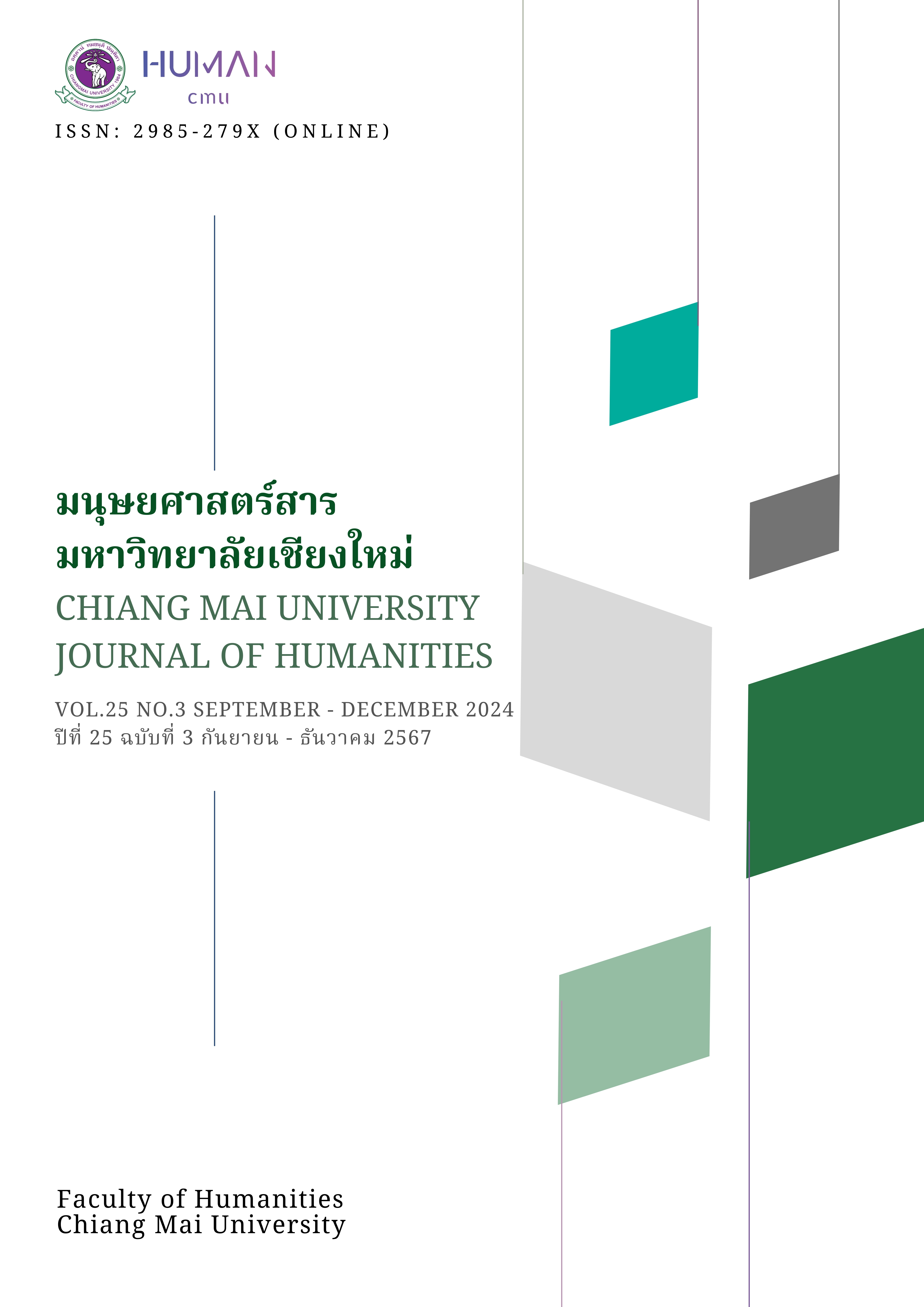ฆ้องหุ่ย เอกลักษณ์ของวงปี่พาทย์ดึกดำบรรพ์ ในฐานะเครื่องดนตรี จากแหล่งกำเนิดข้ามพรมแดน
Main Article Content
บทคัดย่อ
เครื่องดนตรีเป็นองค์ประกอบสำคัญของการดนตรีเป็นที่ทราบโดยทั่วไป การมองและอาศัย
การตีความที่นอกเหนือไปกว่าเรื่องเสียงของเครื่องดนตรีสู่การมีมโนทัศน์การดำรงอยู่ของเครื่องดนตรี หรือ
ภววิทยาของเครื่องดนตรี บทความนี้มีประเด็นที่นำเสนอคือการไตร่ตรองไปที่เครื่องดนตรีไทย และพิเคราะห์กระบวนการประกอบสร้างฆ้องหุ่ยจากความเป็นจริงของประวัติศาสตร์ การใช้งาน และประสบการณ์ทางสังคม จากฆ้องชนิดหนึ่งที่เป็นเครื่องดนตรีข้ามพรมแดนไทย-พม่า เป็นสินค้าที่มีการประสานประโยชน์ของกลุ่ม
ชาติพันธุ์ที่หลากหลาย และมีความหมายในพรมแดนหนึ่งอย่างหนึ่งและเมื่อข้ามพรมแดนมาความหมายของฆ้องจึงเปลี่ยนไป ฆ้องหุ่ยไม่ได้มีสถานะเป็นฆ้องหุ่ยตั้งแต่ต้นทางจนถึงสนามการค้าชายแดน การที่นักดนตรีไทยข้ามแดนและไปเลือกสรรฆ้องหุ่ยเป็นปฐมเหตุของการเปลี่ยนแปลงสถานะ กระบวนการสร้างฆ้องหุ่ยจึงเป็นการปรับแปลงและดัดแปลงความเป็นดนตรีไทยเข้าไปในฆ้องหุ่ยเพื่อให้ฆ้องหุ่ยมีหน้าที่เป็นเครื่องดนตรีไทยจากการเทียบเสียงไทยและการใช้งาน กระทั่งได้ถูกรับเข้าเป็นตัวแทนในการสร้างเอกลักษณ์ของวงปี่พาทย์
ดึกดำบรรพ์
Article Details

อนุญาตภายใต้เงื่อนไข Creative Commons Attribution-NonCommercial-NoDerivatives 4.0 International License.
เอกสารอ้างอิง
จักรกริช สังขมณี. (2551). พรมแดนศึกษา และมานุษยวิทยาชายแดน: การเปิดพื้นที่ สร้างเขตแดน และการข้ามพรมแดนของความรู้. วารสารสังคมศาสตร์, 20(2), 209-266.
เตภิตา เสือหัน และอรศิริ ปาณินท์. (2558). พลวัตทางสถาปัตยกรรมพื้นถิ่นของชาวจีนฮ่อ: กรณีศึกษาหมู่บ้านสันติชล ตำบลเวียงใต้ อำเภอปาย จังหวัดแม่ฮ่องสอน. วารสารอิเล็กทรอนิกส์ Veridian มหาวิทยาลัยศิลปากร (มนุษยศาสตร์สังคมศาสตร์และศิลปะ), 8(2), 2953-2966.
ธนิต อยู่โพธิ์. (2523). เครื่องดนตรีไทยพร้อมด้วยตำนานการผสมวงมโหรี ปี่พาทย์ และเครื่องสาย. โรงพิมพ์การศาสนา.
ธรณัส หินอ่อน. (2557). การประสมวงดนตรีไทย. มหาวิทยาลัยขอนแก่น.
นฤพนธ์ ด้วงวิเศษ. (2565). สังคมศาสตร์กับจุดเปลี่ยนทางภววิทยา. วารสารสังคมศาสตร์และมนุษยศาสตร์, 48(1), 1-16.
บุญธรรม ตราโมท. (2540). คำบรรยายวิชาดุริยางคศาสตร์ไทย โดยนายบุญธรรม ตราโมท พ.ศ.๒๔๘๑.
ศิลปสนองการพิมพ์.
เบน แอนเดอร์สัน. (2552). Imagined Communities [ชุมชนจินตกรรม]. มูลนิธิโครงการตำราสังคมศาสตร์และมนุษยศาสตร์.
พิชิต ชัยเสรี. (2559). สังคีตลักษณ์วิเคราะห์. สำนักพิมพ์แห่งจุฬาลงกรณ์มหาวิทยาลัย.
มรกต เจวจินดา ไมยเออร์. (2556). เขตแดน พรมแดน และมรดกทางวัฒนธรรมข้ามพรมแดน: จากอียูถึงปราสาทพระวิหารและอาเซียน. วารสารอารยธรรมศึกษา โขง-สาละวิน, 4(2), 63-72.
วารุณี โอสถารมย์. (2548). ประชุมประกาศรัชการที่ 4 กับจักรพรรดิราชสมัยใหม่. ใน ชาญวิทย์ เกษตรศิริ และกัณฐิกา ศรีอุดม (บ.ก.), พระเจ้ากรุงสยาม กับ เซอร์จอห์น เบาว์ริง (น. 326-366). มูลนิธิโครงการตำราสังคมศาสตร์และมนุษยศาสตร์.
อัญชริญา จันทรปิฎก. (2562). บทวิจารณ์หนังสือ “The Border คน พรมแดน รัฐชาติ”. วารสารมหาวิทยาลัยราชภัฏยะลา, 14(2), 315-317.
Chaloemtiarana, T. (2018). Read till it shatters Nationalism and identity in modern Thai literature. ANU Press.
Garzoli, J. (2015). The Myth of Equidistance in Thai Tuning. Analytical Approaches to world music, 4(2), 1-29.
Hall, D. G. E. (1981). A History of South-East Asia (4th edition). The Macmillan Press.
Moro, P. (2004). Construction of Nation and the Classicisation of Music: Comparative Perspectives from Southeast and South Asia. Journal of Southeast Asian Studies, 35(2), 187-211.
Thompson, E. C. (2012). The World Beyond the Nation in Southeast Asian Museums. Journal of Social Issues in Southeast Asia, 27(1), 54-83.
Winichakul, T. (1994). Siam Mapped A History of Geo-Body of A Nation. University of Hawaii Press.
Wisuttipat, M. (2016). The Theoretical Concepts on Thai Classical Music. Santisiri Press.


